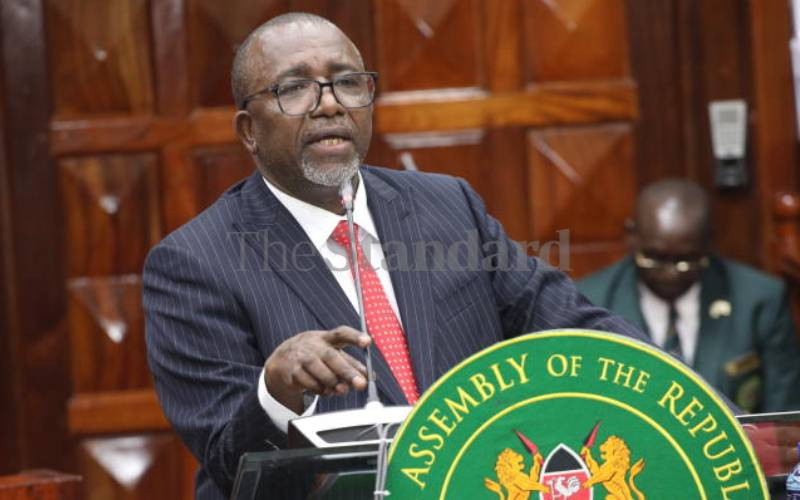Evelyn Ogutu
King David, the biblical psalmist renown for his ‘praise and worship’, danced for the Lord until he tore off his clothes. Yet the Catholic, Presbyterian, Anglican, Seventh Day Adventist and African Inland churches, among others, have traditionally not entertained vigorous singing and dancing in their liturgies. But things are changing, especially in Africa, and liturgical dancing is gaining popularity.
Century-old hymnbooks, such as Tumshangilie Bwana and Golden Bells, are rarely used as most churches have come up with catchy tunes that go in tandem with dancing and clapping of hands.
"The music and dancing makes the liturgy more lively. Churches should emphasise catchy tunes, not boring songs that make the faithful fall asleep in church," says Jane Njeri, 15, a dancer with Holy Family Basilica’s active youth group.
It is a Saturday afternoon and a group of 80 youth are gathered at the Holy Family Basilica Hall. The young boys and girls start off their meeting by reciting the rosary and other prayers before they begin the meeting.
 |
Dance offers an enormous range of forms and expressions in worship from the carefully choreographed dramatic presentation to the spontaneous worship and celebration of individuals and congregations of all ages. [PHOTOs: photos.com] |
One of the agenda items is to find out from the choir what songs it will be singing on Easter Sunday so the group can start practicing suitable dance moves.
Just 10 years ago, this was unheard in the Catholic Church. But the youths demanded an entertaining way to praise and worship God and the church has now incorporated liturgical dancing.
"The youth are part of the international group, the Pontifical Mission for Children, and they participate in various activities in the church — as dancers and altar servers, for example," says Fr Francis Mbuthia, the assistant parish priest at the basilica.
Fr Peter Githinji, the parish priest of Nanyuki Catholic Church says the church encourages only ‘sacred dancing’ and liturgical dancers are advised not to dance provocatively.
That they are allowed to dance at all is controversial, as the Catholic Church in the West frowns upon it. According to an essay published by the official organ of the then Congregation for the Sacraments and Divine Worship, Notitiae in 1982, all dancing including ballet, children’s gesture as dancing and the clown liturgy was not permitted to be "introduced into liturgical celebrations of any kind whatsoever".
However, a certain form of dance could be introduced within the context of papal liturgies at regional synods of bishops or canonisation ceremonies. But, these were usually associated with elements of African or Asian culture and were considered as special exceptions in virtue of the Pope’s universal mission.
But Cardinal Francis Arinze — an African himself — prefect of the Congregation for Divine Worship and the Sacraments, has publicly criticised certain forms of dance in Western liturgy especially in forms that reduce the sacred rite to a spectacle.
Not part of Latin worship
In the Latin Church, liturgical dance has never been made an integral part of the official worship.
Stay informed. Subscribe to our newsletter
In Kenya and many African countries, local churches have accepted the dance especially on the occasion of feasts like Easter, the nativity of the Lord and other Church celebrations.
Fr Mbuthia says liturgical dance can turn into prayer that expresses itself with a movement that engages the whole being — soul and body.
"We are told in the bible how David danced to the Lord and this should happen also when our youths dance in during offertory or entrance," he says.
However, some church members feel, the young generation is taking the dance too far and instead of it being praise and worship time which should be sacred, the dance sometimes distracts the members of the congregation.
Fredrick Wanjohi, a Church elder at St Joseph Mukasa, Kahawa West Parish, who is also in charge of the Ministry of Marriage and Family in the parish, says the liturgical dances should be controlled and serve the purpose that they were created for — for praise and worship.
"Sometimes, our dancers go overboard with their provocative dancing styles which distracts the faithful from following the liturgy. Hence the need to control the dances," he says.
However, at a place like Holy Family Basilica, there is always a priest or a deacon who ensures that the mass servers and dancers act as per the liturgy, hence there is no deviation.
Fr Githinji, says that sometimes, if the young faithful are not instructed on how to dance or what is expected of them during the liturgical dances, they might go overboard in their dancing styles.
Avellino Muhonja, an altar girl at Holy Family Basilica who participates in liturgical dancing when not serving, says the dancing makes the mass interesting.
"Sometimes people tend to sleep in church, but when the mass is made livelier by such dances and songs, the faithful also participate in the liturgy," she says.
The 11-year-old girl says she has been dancing in church for five years now.
Dance costumes
Fr Githinji says sometimes the Church buys some dancing costumes like lesos and t-shirts for the dancers. In several dioceses and archdioceses, the liturgical dancers also participate in dancing and singing competitions with other parishes.
"This is a way of making our young people active. They do not have to waste time idling in the estates or watching TV but can come to church and mingle with their age mates as they pray and also serve Christ in various ministries," adds the priest.
In various churches, there are teachers who volunteer to teach the interested dancers various dance styles. In most churches the teachers are also part of the liturgical committees which overseas the liturgy.
Banned by priests
However, in some churches the dancing has been banned by some priests who say it is against the laid down liturgical rules.
However, Pastor Kyama Mugambi of Mavuno Church Downtown in Nairobi, which has a huge following of young people, says music is a form of worshipping God.
"There is abundant joy where God is. We therefore believe that our gathering as God’s people is to be an exciting event that is vibrant and joyful," he says.
Mugambi says churches should make services a joyful event of praising God by singing and dancing.
 The Standard Group Plc is a
multi-media organization with investments in media platforms spanning newspaper
print operations, television, radio broadcasting, digital and online services. The
Standard Group is recognized as a leading multi-media house in Kenya with a key
influence in matters of national and international interest.
The Standard Group Plc is a
multi-media organization with investments in media platforms spanning newspaper
print operations, television, radio broadcasting, digital and online services. The
Standard Group is recognized as a leading multi-media house in Kenya with a key
influence in matters of national and international interest.
 The Standard Group Plc is a
multi-media organization with investments in media platforms spanning newspaper
print operations, television, radio broadcasting, digital and online services. The
Standard Group is recognized as a leading multi-media house in Kenya with a key
influence in matters of national and international interest.
The Standard Group Plc is a
multi-media organization with investments in media platforms spanning newspaper
print operations, television, radio broadcasting, digital and online services. The
Standard Group is recognized as a leading multi-media house in Kenya with a key
influence in matters of national and international interest.






